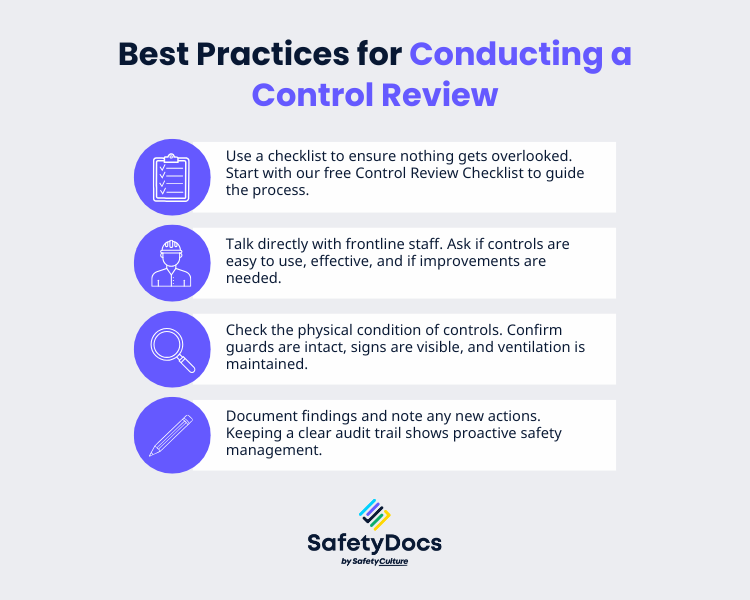This is the fourth in a four-part series on building a comprehensive workplace safety system.
Your Safety Plan Isn’t a Set-and-Forget Document
In the first three weeks of our series, you've done the hard work: You've identified hazards, assessed risks, and implemented controls. But the job isn't done. The final and most crucial step in the safety cycle is to review your controls.
A safety plan isn't a "set and forget" document. Things change: people leave, new equipment is introduced, and work processes evolve. A control measure that was effective six months ago might not be today. Without regular review, your controls can become ineffective, creating a false sense of security.
The Benefits of a Regular Review
A review isn't just about ticking a box; it's about building a better, more resilient business. Here’s why a consistent review process is one of the most valuable things you can do.
- Catching Issues Early: Think of a review as an early warning system. It allows you to spot potential failures in your control measures before they lead to an incident. A machine guard might be loose, a safety procedure might be confusing, or a new hazard might have emerged. A regular review helps you fix these issues early, preventing costly accidents, injuries, or even fatalities.
- Driving Continual Improvement: A review isn’t about finding fault; it’s about finding opportunities to improve. By asking, "Could we do this better?" you foster a culture of continuous improvement. This proactive mindset not only makes your workplace safer but can also lead to more efficient and streamlined processes over time.
- Maintaining Compliance: Under the Australian Work Health and Safety (WHS) Act, businesses have a legal duty to review their control measures to ensure they remain effective regularly. A consistent review process is your documented proof that you meet this legal obligation, helping you avoid hefty fines, legal costs, and reputational damage.
- Boosting Employee Engagement: Involving your team in the review process shows you value their input. It gives them a voice and empowers them to take ownership of safety. This collaboration builds trust, boosts morale, and encourages them to comply more with safety procedures, leading to a stronger safety culture.
When to Review Your Controls
A good safety review is all about timing. Knowing when to review is just as important as knowing how.
- At Scheduled Intervals: A good practice is to set a review schedule, typically every six to twelve months, depending on the level of risk. High-risk controls should be reviewed more frequently, perhaps every 3-6 months.
- After an Incident or Near-Miss: A review is mandatory after a serious injury, a near-miss, or a dangerous occurrence. It's a critical investigation that helps you understand exactly what went wrong and what needs to be changed to prevent it from happening again.
- When Processes or Equipment Change: If you introduce new equipment or materials or change a work process, your existing controls might no longer be effective. To account for any new risks, it is essential to conduct a review before the changes are implemented.
- When Controls Aren’t Working: If you notice that a control measure is being ignored, is challenging to use, or has been compromised, it's a clear sign that it needs to be reviewed immediately.
How to Conduct a Control Review
A thorough review involves a mix of administrative and on-the-ground checks.
- Use a Checklist: A structured checklist is essential to ensure you don’t miss any steps. Our free Control Review Checklist is a great place to start.
- Consult with Workers: Talk to the people on the front lines. Ask them questions like: "Is this control easy to use?" "Is it effective?" "Have you noticed anything that could be improved?"
- Inspect the Controls: Physically inspect the control measures. Is the machine guard in good condition? Are safety signs visible and legible? Has the ventilation system been maintained?
- Update Your Records: Record the findings of your review, including any new actions that need to be taken. This creates a documented audit trail that shows you are proactive about safety.

The Financial and Social Impact
A strong review process isn't just about avoiding legal issues, but also about business performance. Workplaces with a proactive approach to safety often see:
- Lower Insurance Premiums: Fewer incidents and injuries can significantly reduce your workers' compensation premiums.
- Reduced Lost Time: Fewer accidents mean less time lost to injuries, improving productivity and operational efficiency.
- Improved Employee Morale: When workers feel safe and know their employer cares about their well-being, morale, loyalty, and productivity naturally increase.
Frequently Asked Questions
Q: Do I need to review every control? Yes, it is essential to review every control to ensure a safe and compliant workplace.
Q: How often should I review my controls? It depends on the level of risk. High-risk controls should be reviewed more frequently, perhaps every 3-6 months. Low-risk controls can be reviewed less often, like once a year.
Q: Can I use an app to manage this? Yes, many companies use safety management software to track reviews, send reminders, and create an easily searchable record of their safety efforts.
Q: What if I find a problem during a review? If you find an issue, treat it like a new hazard. Assess the risk, implement a new control, and then add a new review date to your register to resolve the issue.
Your Complete Safety Toolkit
Congratulations! You've successfully completed our four-part Safe Work Month series. By following these steps, you’ve built a comprehensive safety management system. From identifying your hazards and assessing your risks to controlling and reviewing them, you now have the tools you need to protect your business and your team.
Remember, when you download our Safety Essentials Pack, it includes:
- Hazard Identification Checklist
- Risk Assessment Template + How-To Guide
- Control Measures Register
- Control Review Checklist
and you will have a complete, ready-to-use risk assessment process for your business. Click here to download.
Looking to take the next step in your safety journey? Our team of specialists can help. Whether you need more information, tailored policies, or complete safety management systems, we’re here to help you protect your business. Contact our Customer Care Specialists to learn more about our full suite of professional resources.
Author - Craig Cruickshank is the HSEQ Manager and Senior Technical Advisor at SafetyDocs by SafetyCulture.
Craig comes from a construction and environmental background, with experience in both the private and public sectors and is passionate about making health and safety information easy to find and understand for everyone.
Learn more about Craig's work on LinkedIn
Available for instant download and supplied in fully editable MS Word format for use in your business.
Please note that the above information is provided as a comment only and should not be relied on as professional, legal or financial advice.
Share This Article
